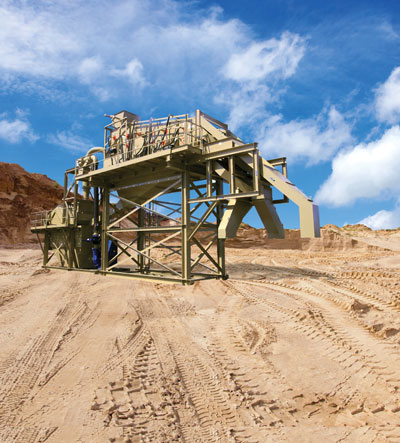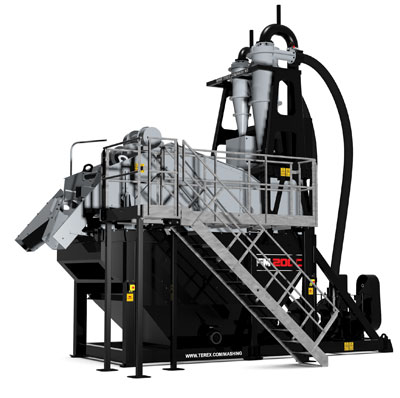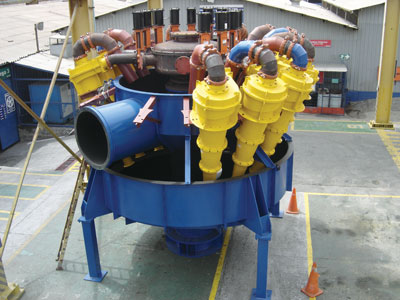
Features
Aggregates
Technology
Washing Sand and Rock
New technology allows companies to keep more profits by washing materials that were seen as waste.
April 17, 2013 By Treena Hein
Ongoing innovation is the key to success in any field – and the aggregate sector is no exception.
Ongoing innovation is the key to success in any field – and the aggregate sector is no exception. New washing system designs are allowing companies to do better washing in comparison to what can be done using traditional equipment, and more water is being eliminated to boot. These new innovations are allowing aggregate suppliers to meet customer demand for cleaner product, while also enabling better stacking and quicker movement of product to market. New equipment is also making it possible for companies to access new markets for things like specialty sands.
 |
|
| KPI-JCI’s #1892S washing system enables aggregate producers requiring a single plant to rinse and size up to three stone products while simultaneously washing, dewatering and fine-tuning one or two sand products.
|
In years past, the focus was placed on how many tons were put into a stockpile, notes Rick Madara, but production managers now put just as much emphasis on how much material is being wasted. “Producers look to companies for ways of making their process more efficient with minimal waste,” says the aggregate division sales manager at McLanahan Corporation. “Equipment that can make sharper product separation, such as hydrosizers, separators and cyclones, will continue to be looked at as a viable choice for wet processing. Dewatering screens, which typically produce as much as a 50% drier product than a traditional screw washer, may be a better choice in many applications.”
Matthias Bremer, an innovation engineer at W.S. Tyler Canada, agrees that traditional washing systems such as log washers and washing drums are no longer the best choice in some cases.
“Because they soak the material to clean it off, these machines consume large amounts of water and energy,” he says. Bremer notes that W.S. Tyler’s Hydro-Clean system effectively cleans deleterious material from most aggregates with up to 75% reduced water consumption and up to 15% less energy costs over traditional systems.
The system is also heavy-duty. “Rock caked with heavy clay is often deemed ‘unwashable’ by traditional machines,” Bremer notes. “The Hydro-Clean eliminates this problem, as its unique design ensures virtually any material is washed clean, resulting in better prices for higher-quality materials and new profits.” Taking a maximum feed size of up to six inches (150 millimetres) into its vertical drum, the Hydro-Clean employs multiple high-pressure nozzles, rotating at 90 r.p.m., to spray up to 90% recycled water into holes and cracks in rock that are difficult to reach with traditional equipment.
 |
|
| The Terex FM Compact range uses centrifugal force within the cyclone(s) to remove clay, silt and slime from the sand to bring it into specification.
|
“The washed rocks work their way down the drum and exit onto a discharge conveyor that leads to a standard wash screen, removing any remaining dirt or clay still on the stone as it fractionates the material,” Bremer explains. “The resulting dirty water flows through polyurethane screen mesh installed in the sides of the washing drum.” It’s then collected by a wastewater pipe and sent to a treatment system for additional fine screening.” The Hydro-Clean removes silt and clay particles as small as 63 microns, and is available in three sizes that process between 20 to 400 tons per hour.
The units’ modular design allows them to fit easily into an existing plant or operate as
permanent/mobile standalone washers.
The aggressive scrubbing technology of the PS Range washing system also enables processing of materials with high clay content. It’s offered by Terex Washing Systems (TWS), a newly launched product line within Terex Material Processing, explains marketing manager Elaine Donaghy. TWS is also about to unveil a new washing system called the AggreSand, which combines aggregate washing and screening with sand processing on a single modular chassis.
In August 2012, TWS launched its Plant Automation & Controls Service (PACS), a fully integrated control system for the entire range of the company’s equipment that provides high efficiency. Late last year, TWS also released its Dual Power control system, available on all versions of the Terex M-Range Wash Plant. “This was in response to the recognized increased focus on energy efficiency and alternative improved methods of running mobile machinery,” says Donaghy.
“Traditionally diesel-hydraulic drive systems have been used for both machine movement and operation, resulting in significant fuel costs.” The Terex Dual Power system features both diesel-hydraulic and electrical-hydraulic drives, allowing customers to start, transport and operate the machine using the standard diesel engine. Once in position, if an electrical power source is available, the machine can be plugged in and the electrical-hydraulic drive provides significantly lower running costs.
Weir Minerals is putting the focus on helping companies achieve better classification in the wet part of their plants, which allows them to both reduce loading in downstream parts of their plants and meet tighter specs. The key to more efficient classification, notes Weir Minerals senior process engineer Alan Bennetts, is in improved performance of the cyclone, the first step in many washing processes. “Our Cavex cyclone design allows the process to be more exact and predictable,” he says. “This has a cascade effect on the full system that includes the capture of more material to avoid waste ponds and reduce the output of spec material in the waste stream.” Weir Minerals has also updated the design of their hydrosizer. Bennetts says their current hydrosizer fully utilizes teeter water without creating dead spots or short-circuiting.
Sand for sale
According to Jeff Wendte, the use of equipment such as cyclones, density separators and dewatering screens for the production of construction sands and speciality sands has increased significantly over the past few years. “The frac sand boom has really spurred the use of this equipment within the U.S. construction aggregates business, and manufacturers have been forced to adapt and offer this equipment as an alternative to the traditional methods,” notes Wendte, the product manager of KPI-JCI’s washing and classifying line.

|
|
| Weir Minerals is focusing on helping companies achieve better classification in the wet part of their plants, which allows them to both reduce loading in downstream parts of their plants and meet tighter specs.
|
He says fractionated sand processing plants allow aggregate producers to provide a wide variety of specification sand products all from one processing plant, which in turn allows them to sell material in new markets. KPI-JCI’s new Model #1892S washing system enables aggregate producers requiring a single plant to rinse and size up to three stone products – while simultaneously washing, dewatering and fine-tuning one or two sand products. “The plant features a conventional three-deck, wet, 10-degree screen to rinse and size the stone products,” Wendte says, “while the sand portion of the feed material is processed through a slurry sump and slurry pump, classifying cyclone and dewatering screen to provide a washed sand product containing approximately 10 to 15% moisture content by weight.” Model #1892S plants are available in stationary, semi-portable/skid-mounted or portable configurations and with a variety of equipment sizes. Typically, each plant is custom-designed, says Wendte.
Madara at McLanahan also agrees that the use of separators/cyclones and dewatering screens provides a much more efficient way of processing sand and provides a drier product, which has proven to be extremely important in today’s market. Industrial sand is in the middle of a sales boom, Madara confirms, with high demand for frac sands in some regions. Frac sands must meet many specifications (relating to things like particle shape, particle soundness and a tight product gradation) and to meet them, Madara says, selecting the right equipment and process is critical.
“Proper equipment, plant layout and ‘mass water balance’ all need to be accurately selected in order for the producer to make as much product as possible,” he says, “while staying within the strict product specifications and maintaining low operating costs.” He notes that having the ability to supply both traditional and high-efficiency wet process equipment allows McLanahan to offer customers a variety of solutions and guidance. Its Aggregate Process Division’s team of process engineers can design and recommend equipment that will provide maximal efficiency.
McLanahan has also taken notice of the millions of gallons of water used by an average plant over a year, and has started offering companies better ways to handle waste effluent. “With limited pond space and the need to reuse plant water, McLanahan has invested in designing and manufacturing a line of plate filter presses,” says Madara. “This technology has been widely used and accepted in other countries.” He says McLanahan’s line of plate filter presses, used in conjunction with a deep cone thickener, can provide a much drier product, and operate with far less chemicals and operating costs compared to systems using a belt filter press. “Handling a plant’s waste stream is a crucial part of any plant that incorporates wet processing,” Madara explains. “Plate filter presses can eliminate the use of an effluent pond and drastically reduce the operating costs of maintaining the waste stream.” McLanahan now has many of these units operating domestically, and Madara says inquiry levels continue to be high. “We anticipate this technology to be common practice in any process concerned with water management,” he states.
TWS also offers a range of equipment that allows water to be recycled. “The use of our deep cone thickeners, small amounts of flocculent dosing and high-pressure filter presses,” notes Donaghy, “are allowing quarry operators to recycle up to 80% of water in washing applications.”
Print this page